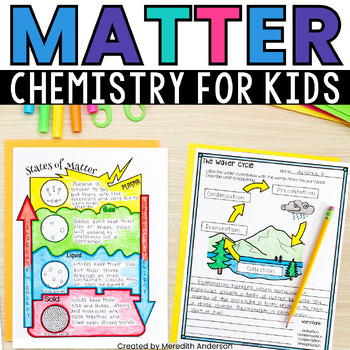States of Matter Activities Experiments Solids, Liquids, Gases Sort Assessments
- PDF
- Easel Assessment
What educators are saying
Description
This matter unit isn't just about solids, liquids, and gases! Dozens of hand-on experiments, activities, and tools are provided in a kid-friendly way to learn ALL about states of matter (solid, liquid, gas, and plasma), physical change and chemical change in matter, elements and compounds, mixtures, and the water cycle.
Use the informational text passages for background information, the sorting, labeling, and worksheet activities to reinforce the concepts, and the chemistry experiments to gain hands-on understanding about these concepts.
⬇️ What You'll Get ⬇️
✅ Teacher Instructions and Plans ✅
Suggested plans are included for the lessons that include student objectives, suggested activities, and page numbers for where to find the activities (there are over 200 pages in this resource!). Additional links are provided to outside resources like websites, videos, and interactive activities.
✅ Informational Text / Reading Passages ✅ These are included in standard (about 1 page per topic) AND easy read format (larger text, more spacing, more images, about 2 pages per topic)
- Matter: Solid, liquid, gas, and plasma (plasma is on its own page in case you would rather leave it out).
- Physical and chemical change
- State change with melting and boiling point
- Elements and compounds
- Mixtures
- Metals, non-metals, and metalloids
- The water cycle
✅ Sorting Activities and Printable Worksheets (color and black and white, 35+ pages included)
- States of matter (solid, liquid, gas) and (solid, liquid, gas, plasma)
- Physical or chemical change? Includes both clip art sorting and photo examples
- Labeling states of matter
- Melting and boiling point printable
✅ Graphic Organizers, Interactive Journals, and Lapbook ✅
Over 20 pages of resources to use in this section! See preview for example of lapbook, or use the pages in your interactive science journals.
✅ Experiments ✅
Over a ⭐ dozen experiments ⭐ are included in this resource! Some have an experiment-specific lab sheet, others you may use one of the two generic lab sheets included or your science journals to record notes and observations.
✅ Science Posters and Word Wall Cards ✅ (10+ posters and 30+ word wall cards) excellent for reference while studying matter!
Posters
- Matter
- Solid
- Liquid
- Gas
- Plasma
- Chemical Change
- Physical Change
- Metals
- Non-metals
- Metalloids
- The Water Cycle
Illustrated Word Wall Cards: Matter, Solid, Liquid, Gas, Plasma, Volume, Mass, Phase Change, Physical Change, Chemical Change, Boiling, Freezing, Melting, Condensing, Sublimation, Deposition Atom, Compound, Element, Metal, Non-Metal, Metalloid, Insulator, Conductor, Malleable, Ductile, Mixture, Solution, The Water Cycle, Evaporation, Condensation, Precipitation, Collection (Accumulation included as an alternate)
✅ Assessments ✅
Three assessments are included. All assessments have two levels. Use the one that works best for your students, or use one as a follow-up comprehension page to the reading material and the other as a formal assessment.
The reading passages may be challenging for some third graders, but they can be read aloud or with partners. The content itself is appropriate and comprehensible for grades 2-3, but I wanted to make sure it is clear that the passages are not necessarily meant for independent reading.
What Teachers Are Saying
⭐⭐⭐⭐⭐ "There is so much here and you can pick and choose which parts you want to use or that you have time for. It is a very well done resource and honestly couldn't be happy with the purchase!!"
⭐⭐⭐⭐⭐ "This is a well thought out resource that can be used for so many styles of learning. We enjoyed this so much."
⭐⭐⭐⭐⭐ "I look forward to using this material with my States of Matter and Change Unit. Love the background information for the teacher and the clear explanations and illustrations for the students."
Looking for a digital chemistry resource?
Matter Digital Interactive Notebook is for use with Google Drive and Google Classroom. If you are looking to integrate technology into your science learning, please visit this resource!






